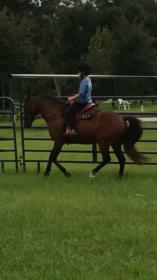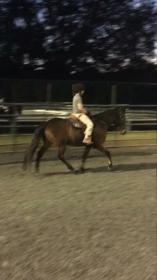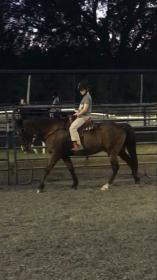A sweet friend of mine lives in Europe (they move around a bit, but tend to stay near Germany). She’s young (like early teens) and doesn’t come from a horse family. She’s been taking dressage lessons at this barn for well over a year and her mom posts videos of parts of her lessons sometimes. I’m not a professionally trained dressage rider, trainer, or instructor, so I’m not 100% sure what I’m seeing in these videos, but they strike me as wrong. Every horse used in the lessons has the type of side reins that are designed more like draw reins (attached at the girth between the front legs & the saddle d-rings sliding freely through the bit rings). The horses appear strung out and the riders look like they’re trying hard, but maybe too hard to scoop into the saddle for the canter. Riders are all using reins as well as the side reins. I’m not comfortable sharing the videos since they’re set to friends-only privacy. I was just wondering why all the horses would require these side reins in every lesson that I’ve seen? Is it a dressage thing? Is it just a lesson barn (maybe even just this lesson barn) thing? If this is out of line, please forgive me. I’m by no means anti-dressage (I taught myself quite a bit by reading and picking my mom’s brain from when she took dressage lessons). In college when I took my Advanced Horsemanship classes (both English and Western), my instructor was impressed enough to ask me to be on the Equestrian team, so I’m not a complete dummy. I’m also not anti-bit/bridle/etc. I just don’t see dressage when I see these videos. I realize you can’t 100% explain what I’m seeing without seeing the videos, but could you help an inquisitive horsewoman out by giving me some ideas? Thanks!
I can’t comment on whether what you are seeing is correct or not. However, it’s not uncommon to see traditional side reins from girth to bit on lower level lesson horses in Europe.
Whether you agree with it or not, it comes from a good place. The idea is that it is healthier for the horse to go around round, with the back up, than to go around inverted/hollow when being ridden by a beginner who isn’t capable of putting the horse on the bit themselves yet. Similarly, it’s more comfortable to learn to sit on a horse that is round and giving you a place to sit. It’s also helpful for the rider to learn the feeling of a round horse before they have to produce it themselves.
This ^^
In my experience it is done to protect the horse. Going around incorrectly for lesson after lesson is terrible for a horse’s long-term soundness. Pain leads to grumpy horses which leads to frustrated students who are more likely to over use a whip or spur or yank on the mouth… and on and on the cycle goes. I have only ever used actual side reins for lunging lessons. A bungee neck stretcher or stabilizing rein are fairly effective and benign for both horse and rider and can be used off the lunge line.
Thanks.
If they’re reins that go from the girth, between the front legs, through the bit rings, and back to the billet, those are Vienna Reins, and are used to keep the horse stretching over the back so the beginner can get a “feel” for what on the bit feels like. It’s not at all uncommon to see lesson horses like this in europe. It’s not common here in the states.
Although this practice sold as being healthier for the horse by some, it is more that it creates a very submissive horse that is easier for the beginner rider. In some places, children can even show in side reins.
The problem is, that putting side reins/draw reins/whatever, doesn’t make a horse use its back…it is more complicated than that. Side reins/draw reins just force the head position, and with an inadequate ride, will just force the horse more on its forehand and still leave the horse with a weak back and unhealthy posture. Further to that, the forced submission, and lack of relief (inability to stretch) is unhealthy for horse, as is the fixed head position at gaits that should have some movement (canter and walk, or going from working to extended trots for examples).
It is unlikely to teach what “on the bit” feels like, as horses ridden this way by beginners will develop locked/stiff jaws to protect themselves, although it does reduce the need for riders to feel they need to fiddle with the reins, and can help rider’s learn to not use the reins for balance.
The physical and psychological risk to the horse seems to me to outweigh any benefit though, which is likely why it is rare to see here.
I don’t like the idea, but I understand it is common practice in Germany. There have been previous threads on COTH where its been discussed at some length and even links posted but I don’t think that was the actual title of the thread. Thats how I know all about it!
These a not side reins. They are called Vienna reins or a German Martingale. They are used to protect a horse’s mouth from beginner hands.
The same horses can be used in advanced lessons without the reins. So the horses can be ridden with and without.
Basically they work as a an automatic draw rein. If you think of draw reins as being manual draw reins.
The fact that you think the horses are strung out means they are not being pulled in by clicking on the too tight d ring.
Yes, it is very common here. I am on the fence about it.
On the one hand, it may be easier for the beginner to learn. Perhaps it is better for the horse because they are traveling in a more correct shape (not inverted), are less likely to get banged in the mouth, and experience less beginner error. It does let the rider experience a different feel to the horse.
However, with Vienna reins there is no release. The horse does not get to stretch fully, and what happens if the horse trips, stumbles, whatever and there is no release or less freedom of the head? I know that isn’t common, but I think about it.
I also think it depends on the stable because some riders ride too long with the Vienna reins. I think they need to learn how to create that feel and get a horse moving correctly. Or not be dependent on an aid. Some also jump with them on, which I am not crazy about.
I also think they should not compete in them. No riders should compete until they are ready to control the horse without an aid such as Vienna reins.
The reins do release quite a bit if the rider lets go of the reins which would happen most of the time with a beginner. The OP said they were strung out so they would be able to lift their head quite a bit if they trip.
I agree that a rider is not really riding until tjey can ride without them.
Vienna reins or sliding side reins are usually fixed at the saddle pommel height. That way they are distinctly different from draw reins.
T.hey are also useful if one has a horse that has a habit of throwing their head up and going hollow
Why are they called sliding side reins if they are fixed? Do vienna reins go from the side or from between the chest?
The German martingale goes from between the chest, through the bit and clips to a d ring on the reins.
Sliding side/vienna reins are “less fixed.” They go from between the legs or at the girth on the side of the horse, through the bit, then back to the saddle somewhere in a V. Because they slide through the bit the horse has more range of motion than a single side rein but less range of motion than a german martingale.
A german is the way you describe and when the reins are not held, or held on the buckle the horse has all or almost all free range motion. A german is better in the hands of an inexperienced person because it only activates at a certain point that has nothing to do with the person (besides the length they hold the reins). I like a german because I just have to hold my reins at the right length and ride forward. The horse hits the martingale when he’s outside of the box I have set for him and self corrects. Now, if I have it set too tight it is of course punishing but I have mostly used it for head flingers and not to “set” the head. It saves my face.
Personally I would rather ride in a German if I am going to ride in anything because once you set vienna/sliding side reins that’s it.
To add to the confusion an arabian or saddlebred martingale is another option but it is used to set the head behind the hand and I can’t stand riding in one because you can’t push the horse into the hand and I feel woefully out of control.
It is quite rare to have lesson horses in the US, so that limits the number of people who can learn to ride. It is much better to learn on a lesson horse prior to buying a horse that is more advanced. The better rider can buy a better horse.
My mom did this with me and my pony when I was little. We started out on the lunge line w/t/c and he was in side reins. When we graduated to the full arena and beyond the side reins came off and we started cross rails and steering, but when I was 7 or so and would ride with the family I think they got sick of telling me “if it rained your pony would drown!” From him being so inverted…So they separated the draw reins and attached them at the pommel. For whatever reason I objected to this strongly and we only used them for a month or so before switching to a martingale (which for reasons unknown to my adult self, I was much happier with) both training aids did help me get a better sense of my pony’s "proper way of going and was able to transition to riding and showing without of them within a year or so.
Ive considered doing this with my 7 year old son and his pony, but lunging the pony in side reins before my son rides keeps him pretty correct through their actual lessons and my son’s just starting to get the idea of steady contact to keep a proper connection and gently massaging the reins “like you’re wringing out a washcloth” to get his pony correct again if his attention wanders. Risk of things going sideways is enough to keep me from putting side reins or draw reins on while he has a passenger.



Is it rare to have lesson horses in North America? It doesn’t seem that way in basic hunt/jump seat. At least in more urban areas. Lots of lesson barns for beginners.
It is true there is not much in the way of beginner dressage lessons. But honestly I don’t think either beginners or dressage are well served by mixing the two. You need independent seat and hands before you can start influencing how the horse moves.
I am not in the US, but I don’t think it is that much different here: lesson horses for beginners are common, and lesson programs are big business. What is rare (in my area) are advanced lesson horses, but that isn’t really applicable to this topic.
Because they don’t know any better, but you knew that, right?
I’d add that you don’t see dressage in those videos for the same reason you don’t see an independent forward seat and following hands in a beginner hunt/jump seat lesson.
Because they are beginners.
There are different choices with beginners.
You can give them seat lessons on the longe no stirrups no reins multiple times a week until they have their balance ( a couple months) and you let them ride. Probably a hard sell for today’s kiddies. Thats the Spanish Riding School model.
You can put them on broken down lesson horses and teach them to kick and yank (and let them jump before they have a decent seat) but not ask for any real influence on how the horse carries himself. Thats the current hunter jumper lesson factory model.
You can put them on better trained ponies with auxiliary reins to get a better ride initially. Thats the German model.
Or, you can buy your beginner ridet daughter her own little horse and a western saddle and let her loose to gallop around the suburbs with other rowdy children. Thats how we learned to ride when I was a kid, and probably how ranch kids still learn to ride (though not in the suburbs). Riding all day every day. It has much to recommend it but is not a lesson program.
There are clear drawbacks to the horse in every scenario. Even longeing beginners is rough on their backs.
My little mare only had to deal with one beginner (after I bought her from the dude string) and within six months, less than that probably, I was not a beginner anymore. My observations at the time was it took me and most of my friends about a month of riding every day to “get your balance,” let go of saddle horn (or mane bareback). Which I would now call having an independent seat.
I honestly don’t know how anyone arrives at an independent seat with weekly lessons.
Anyhow no beginner rider is doing much of the actual discipline.
Lesson horses for beginners are rare in the US. I was in Germany and saw mostly group lessons (with many horses in auxiliary reins) which are also rare here in the US.
